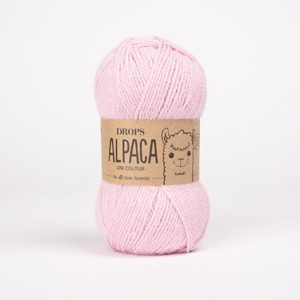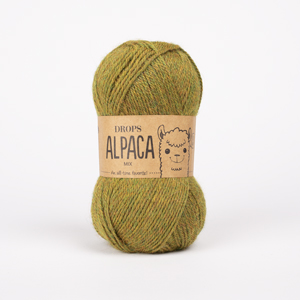Comments / Questions (97)
![]() Alexandra Laffon wrote:
Alexandra Laffon wrote:
Thank you very much for your reply… guess I’ll need to learn to knit!
02.03.2025 - 22:52
![]() Alexandra Laffon wrote:
Alexandra Laffon wrote:
I love this design but I am a crochet person... any ideas on how I could convert it? Or do you have a crochet version? Loved Ulla's from Sweden's version best!
28.02.2025 - 18:31DROPS Design answered:
Dear Alexandra, this pattern is a special pattern, worked sideways and with shortened rows and in garter stitch. So it's very difficult to replicate this in crochet. Also, when crochetting and knitting, even when working a similar garment, the stitch texture won't be exactly the same, as the stitches worked are different, and the shaping won't match as well with crochet stitches.In this link you will find some crochet short sleeve cardigans; maybe one of them will match what you want. Happy crochetting!
02.03.2025 - 19:54
![]() Teresa wrote:
Teresa wrote:
I am knitting size M, completed the left sleeve, and then worked the bottom 34 stitches for 8 cm. I put all stitches back on the needle and continued with the short rows as before. There is one thread joining the sleeve and underarm . Is this correct? It seems like a potential weak point in the jacket. Is this reinforced at the end with three rounds of garter stitches? Or have I made a mistake? Thanks.
17.06.2024 - 01:51DROPS Design answered:
Dear Teresa, the pattern is correct, however, if you find that point week, you can strengthen it with a few stitches. Happy knitting!
17.06.2024 - 04:28
![]() Charo wrote:
Charo wrote:
Tengo una duda, al terminar las vueltas cortas de la manga y pasar los puntos a una aguja auxiliar, hay que cortar el hilo para tejer los puntos que se pusieron en espera? Gracias
20.04.2024 - 17:29DROPS Design answered:
Hola Charo, si el patrón no menciona cortar el hilo o si se puede continuar trabajando el patrón sin cortar el hilo entonces no hace falta cortar.
22.04.2024 - 00:13
![]() Augusta Jensen wrote:
Augusta Jensen wrote:
Hej. Kan jeg strikke den i 2 tråde Baby Merino ?
12.03.2024 - 15:14DROPS Design answered:
Hej Augusta, ja det kan du, for at finde ud af garnforbruget, kan du bruge vores garn-omregner, Vælg Alpaca og skriv antal gram ind som passer til din størrelse, så får du garnforbruget i DROPS Baby Merino :)
13.03.2024 - 15:05
![]() Anette Didriksen wrote:
Anette Didriksen wrote:
Jeg strikker Drops design 117-43. Jeg skal sætte de nederste 34 masker på en tråd(str M) er det maskerne fra den ende der måler ca 7 cm eller maskerne fra kraven
26.02.2023 - 17:06DROPS Design answered:
Hej Anette, det er de nederste masker i siden (under ærmet) som du sætter på en tråd når du skal strikke skulderen/ærmet. Når du er færdig med skulderen skal du fortsætte over alle masker igen :)
28.02.2023 - 15:03
![]() Anette Didriksen wrote:
Anette Didriksen wrote:
Jeg skal til at strikke ærme på model 117-43. Jeg har sat de nederste 34 m på en tråd (str m) jeg forstår ikke hvad der menes med at der nu kun er 18 m før 1. mærke
29.01.2023 - 20:56DROPS Design answered:
Hej Anette, det er mærket hvor du strikker vendepindene vi henviser til :)
31.01.2023 - 11:30
![]() Dee wrote:
Dee wrote:
Is this the same pattern as the Gauginator Shortrow Cardigan #2 that's on Ravelry? This one has 3 buttons and the shortrow one only has 1 and it looks a little longer. I would like to compare them if they are different.
15.12.2022 - 04:46DROPS Design answered:
Dear Dee, sorry, we do not know the pattern you are talking about. If it's a project, you can maybe ask the knitter about her help. Happy knitting!
15.12.2022 - 08:50
![]() Christiane Boos wrote:
Christiane Boos wrote:
Hallo, kann ich die Ärmel auch verlängern? Ich hätte gerne Ärmel bis ca. Ellenbogen. Oder stricke ich einfach den Ärmelteil länger? Danke, Christiane
24.06.2022 - 14:56DROPS Design answered:
Liebe Frau Boos, vielleicht könnte Ihnen dieses Modell damit inspirieren. Viel Spaß beim stricken!
27.06.2022 - 07:51
![]() Anita wrote:
Anita wrote:
Hello Jeanette,Doing XL. On Line 17 from top, of your pattern, I do not understand: slip sts on a new stich holder,*** How many?*** & slip sts from 1st stch holder back on the needle 38. Not clearly explained!!!
04.09.2021 - 23:16DROPS Design answered:
Dear Anita, you slip all of the sts you have been working now on a new stitch holder and then you slip back to the needle the 38 stitches you had in the first stitch holder. Happy knitting!
05.09.2021 - 17:12
Helena#helenavest |
|
|
|
|
Short DROPS jacket with short sleeves knitted from side to side in 2 threads ”Alpaca”. Size XS - XXL
DROPS 117-43 |
|
|
SHORTENED ROWS: * Work row to first marker, turn, tighten thread and work return row, work row to second marker, turn, tighten thread and work return row, work all sts, turn and work return row *, repeat from *-*. 1 repeat = 2 rows at the top and 6 rows at the bottom. ---------------------------------------------------------- ---------------------------------------------------------- JACKET: Worked back and forth on needle from the left side, in garter st, i.e. K all rows. Cast on 75-78-82-85-88-92 sts on needle size 5 mm / US 8 with 1 thread of each color. K 4 rows on all sts (first row = RS). Insert 2 markers in piece from RS as follows: First marker: after 47-49-52-54-56-59 sts Second marker: after a total of 57-60-64-67-70-74 sts = 18 sts after the last marker = collar. Continue with SHORTENED ROWS – see above – until piece measures 6-6.5-7-7.5-8-8.5 cm / 2⅜"-2½"-2¾"-2⅞"-3⅛"-3¼" at the top (= by neck) and approx 16-17.5-19-20.5-22-23.5 cm / 6¼"-6⅞"-7½"-8⅛"-8¾"-9¼" at bottom. Insert a marker at the top by neck – NOW MEASURE PIECE FROM HERE! Slip the bottom 30-32-34-36-38-40 sts on a stitch holder = 45-46-48-49-50-52 sts left on needle for sleeve. Continue with shortened rows as before (but now there are only 17-17-18-18-18-19 sts before first marker) until piece measures approx 7-7.5-8-8.5-9-9.5 cm / 2¾"-2⅞"-3⅛"-3¼"-3½"-3¾" from marker by neck and approx 21-22.5-24-25.5-27-28.5 cm / 8¼"-8⅞"-9½"-10"-10⅝"-11⅛" at bottom (= over sleeve). Slip sts on a new stitch holder and slip sts from the first stitch holder back on needle = 30-32-34-36-38-40 sts. Work garter st back and forth on these sts for 4-6-8-10-12-14 cm / 1½"-2⅜"-3⅛"-4"-4¾"-5½". Now slip all sts back on needle = 75-78-82-85-88-92 sts. Move marker from top of neck to where you are now, and now measure piece from here! Work shortened rows as before until piece measures approx 10-11-12-13-14-15 cm / 4"-4⅜"-4¾"-5⅛"-5½-6" from marker by neck and approx 30-33-36-39-42-45 cm / 11¾"-13"-14¼"-15¼"-16½"-17¾" at bottom. Move marker from top of neck to where you are now, and now measure piece from here! Slip the bottom 30-32-34-36-38-40 sts on a stitch holder = 45-46-48-49-50-52 sts left on needle for sleeve. Continue with shortened rows as before until piece measures approx 7-7.5-8-8.5-9-9.5 cm / 2¾"-2⅞"-3⅛"-3¼"-3½"-3¾" from marker by neck and approx 21-22.5-24-25.5-27-28.5 cm / 8¼"-8⅞"-9½"-10"-10⅝"-11⅛" at the bottom (= over sleeve). Slip sts on a new stitch holder and slip sts from the previous stitch holder back on needle = 30-32-34-36-38-40 sts. Work garter st back and forth on these sts for 4-6-8-10-12-14 cm / 1½"-2⅜"-3⅛"-4"-4¾"-5½". Now slip all sts back on the same needle = 75-78-82-85-88-92 sts. Move marker from top of neck to where you are now, and now measure piece from here! Continue with shortened rows on all sts until piece measures approx 5-5.5-6-6.5-7-7.5 cm / 2"-2¼"-2⅜"-2½"-2¾"-2⅞" from marker by neck and approx 15-16.5-18-19.5-21-22.5 cm / 6"-6½"-7"-7¾"-8¼"-8⅞" at bottom. On next row from RS make 3 buttonholes as follows: * K9, K2 tog, 1 YO *, repeat from *-* a total of 3 times, K remaining sts on row. Work 3 rows garter st on all sts and bind off loosely. ASSEMBLY: Sew on buttons. |
|

|
|
Have you finished this pattern?Tag your pictures with #dropspattern #helenavest or submit them to the #dropsfan gallery. Do you need help with this pattern?You'll find 13 tutorial videos, a Comments/Questions area and more by visiting the pattern on garnstudio.com. © 1982-2025 DROPS Design A/S. We reserve all rights. This document, including all its sub-sections, has copyrights. Read more about what you can do with our patterns at the bottom of each pattern on our site. |












































Post a comment to pattern DROPS 117-43
We would love to hear what you have to say about this pattern!
If you want to leave a question, please make sure you select the correct category in the form below, to speed up the answering process. Required fields are marked *.